Small overlap front
The small overlap front evaluation consists of a driver-side and a passenger-side component. If the results of the two evaluations differ, then the combined small overlap rating is equal to the lower rating.
Driver-side
- Rating applies to 2024-25 models
Tested vehicle: 2019 Audi e-tron quattro Premium Plus 4-door 4wd
The Audi e-tron was introduced in the 2019 model year and was renamed as the Audi Q8 e-tron for the 2024 model year. These ratings also apply to the Audi e-tron Sportback and the Audi Q8 Sportback e-tron.
| Evaluation criteria | Rating |
|---|---|
| Overall driver-side evaluation | |
| Structure and safety cage | |
| Driver injury measures | |
| Head/neck | |
| Chest | |
| Hip/thigh | |
| Lower leg/foot | |
| Driver restraints and dummy kinematics | |
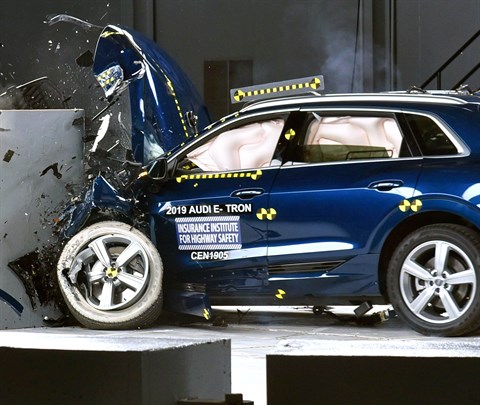
Action shot taken during the driver-side small overlap frontal crash test.
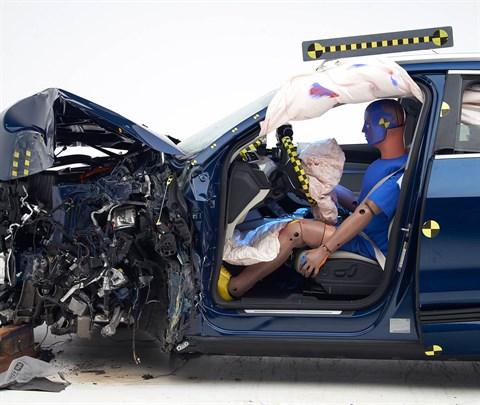
The dummy's position in relation to the door frame, steering wheel, and instrument panel after the crash test indicates that the driver's survival space was maintained very well.
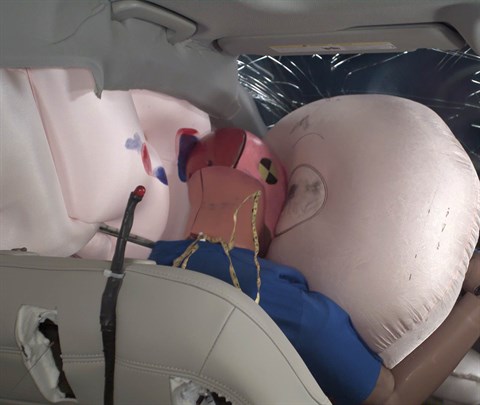
The frontal and side curtain airbags worked well together to keep the head from coming close to any stiff structure or outside objects that could cause injury.
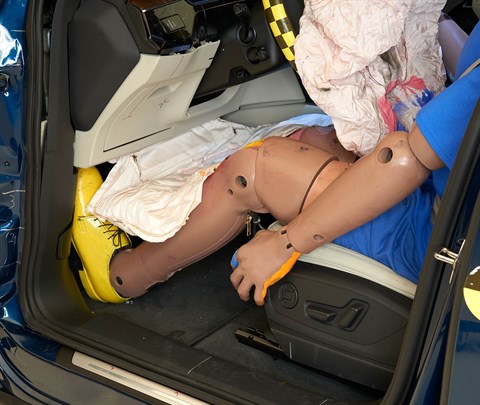
The driver's space was maintained well, and risk of injuries to the dummy's legs and feet was low.
Passenger-side
- Rating applies to 2024-25 models
Tested vehicle: 2019 Audi e-tron quattro 4-door 4wd
The Audi e-tron was introduced in the 2019 model year and was renamed as the Audi Q8 e-tron for the 2024 model year. Passenger-side small overlap frontal ratings are assigned by the Institute based on a test conducted by Volkswagen/Audi. These ratings also apply to the Audi e-tron Sportback and the Audi Q8 Sportback e-tron.
| Evaluation criteria | Rating |
|---|---|
| Overall passenger-side evaluation | |
| Structure and safety cage | |
| Passenger injury measures | |
| Head/neck | |
| Chest | |
| Hip/thigh | |
| Lower leg/foot | |
| Passenger restraints and dummy kinematics | |
| Driver injury measures | |
| Head/neck | |
| Chest | |
| Hip/thigh | |
| Lower leg/foot | |
| Driver restraints and dummy kinematics | |
Moderate overlap front: original test
Rating applies to 2024-25 models
Tested vehicle: 2019 Audi e-tron quattro Premium Plus 4-door 4wd
The Audi e-tron was introduced in the 2019 model year and was renamed as the Audi Q8 e-tron for the 2024 model year. These ratings also apply to the Audi e-tron Sportback and the Audi Q8 Sportback e-tron.
| Evaluation criteria | Rating |
|---|---|
| Overall evaluation | |
| Structure and safety cage | |
| Driver injury measures | |
| Head/neck | |
| Chest | |
| Leg/foot, left | |
| Leg/foot, right | |
| Driver restraints and dummy kinematics | |
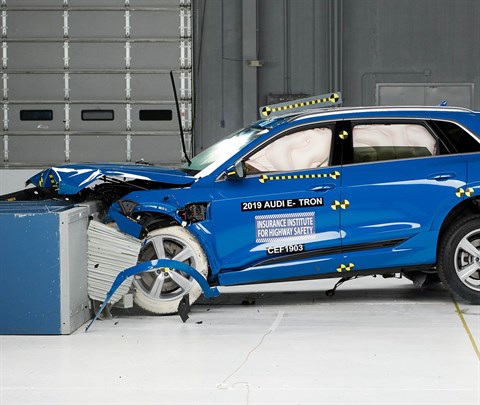
Action shot taken during the moderate overlap frontal crash test.
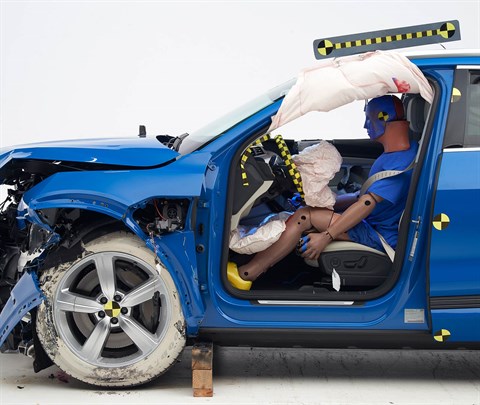
The dummy's position in relation to the steering wheel and instrument panel after the crash test indicates that the driver's survival space was maintained very well.
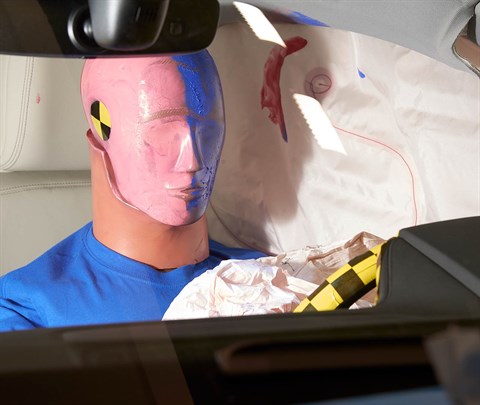
Smeared greasepaint indicates where the dummy's head contacted the side curtain airbag during rebound.
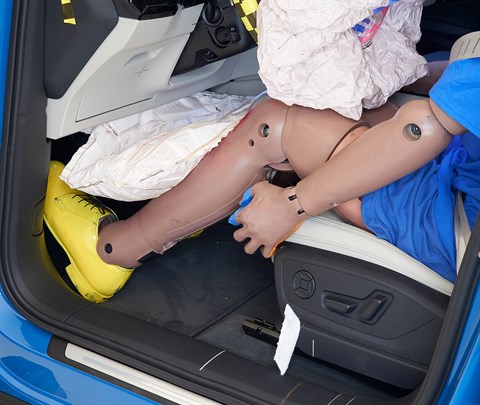
Intrusion into the driver's space was minimal, and all leg and foot injury measures were low.
Side: updated test
Rating applies to 2024-25 models
Tested vehicle: 2023 Audi e-tron S 4-door 4wd
The Audi e-tron was introduced in the 2019 model year and was renamed as the Audi Q8 e-tron for the 2024 model year. Side 2.0 ratings are assigned by the Institute based on a test of a 2023 e-tron conducted by Volkswagen/Audi. These ratings also apply to the Audi e-tron Sportback and the Audi Q8 Sportback e-tron.
| Evaluation criteria | Rating |
|---|---|
| Overall evaluation | |
| Structure and safety cage | |
| Driver injury measures | |
| Head/neck | |
| Torso | |
| Pelvis | |
| Driver head protection | |
| Rear passenger injury measures | |
| Head/neck | |
| Torso | |
| Pelvis | |
| Rear passenger head protection | |
Headlights
Ratings are given for 2 different headlight variations available on this vehicle.
Trim level(s)
- Premium trim
- Premium Plus trim
| Evaluation criteria | Rating |
|---|---|
| Low-beam headlight type | LED projector |
| High-beam headlight type | LED reflector |
| Curve-adaptive? | No |
| High-beam assist? | Yes |
|
Overall rating | |
| Distance at which headlights provide at least 5 lux illumination: | |
Low beams
On the straightaway, visibility was good on the left side of the road and fair on the right side. On curves, visibility was good in all 4 tests.
The low beams created some glare.
High beams
On the straightaway, visibility was good on the right side of the road and fair on the left side. On curves, visibility was good on the gradual right and gradual left curves and fair on the sharp right and sharp left curves.
High-beam assist compensates for some limitations of this vehicle's low beams on the straightaway and on both left curves.
Trim level(s)
- Prestige trim
| Evaluation criteria | Rating |
|---|---|
| Low-beam headlight type | LED projector |
| High-beam headlight type | LED projector |
| Curve-adaptive? | No |
| High-beam assist? | Yes |
|
Overall rating | |
| Distance at which headlights provide at least 5 lux illumination: | |
Low beams
On the straightaway, visibility was fair on both sides of the road. On curves, visibility was good on the sharp right curve, fair on the sharp left curve and inadequate on the gradual right and gradual left curves.
The low beams created some glare.
High beams
On the straightaway, visibility was good on both sides of the road. On curves, visibility was good in all 4 tests.
High-beam assist compensates for some limitations of this vehicle's low beams on the straightaway, on both left curves and on the gradual right curve.
